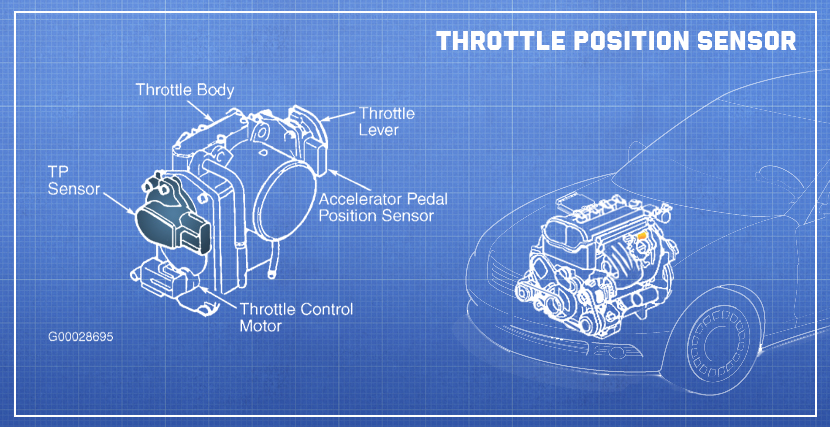Throttle Position Sensor
Your engine relies on the perfect mix of air and fuel to keep the combustion process running. This means each push on the gas pedal and opening of the throttle body must be addressed with the right amount of fuel injected into the engine. To make this possible, your vehicle is equipped with a throttle position sensor, which monitors the position of the throttle body and sends this information to the engine control unit, so it calculates the right amount of fuel.

The information provided by the throttle position sensor is crucial not only for engine operation, but also for proper functioning of some other systems, for example, the anti-lock braking system, which gives the traction aids depending on the throttle position and your vehicle’s speed. The same data are also used for calculating ignition timing and camshaft timing if the latter can be adjusted on the go in your vehicle. All mentioned processes and operations are controlled by the engine control unit, which sends some voltage to the sensor and receives back the certain amount of voltage that varies depending on the sensor resistance.
It goes without saying that incorrect throttle position sensor operation will lead to engine problems. For this reason, we recommend you to pay attention to the most common symptoms of a bad throttle position sensor:
Illuminated check engine light
Your engine control unit not only receives data from the throttle position sensor, but also compares them to the information supplied by other sensors. If it detects irregularities in the sensor operation, it will turn on the check engine light and set a specific trouble code.
Poor acceleration and performance
The primary job of the throttle position sensor is to let the engine control unit know how much fuel should be injected into the engine at a specific time. If the sensor supplies incorrect information, the computer can add too much or too little fuel into the fuel/air mixture. Both scenarios will lead to improper engine operation and a lack of performance.
Engine bucking or jerking
In some cases, a faulty throttle position sensor can supply erratic voltage to the engine control unit. This will cause the computer to think you’re quickly depressing and releasing the gas pedal.
Engine stalling or surging
Your throttle position sensor is also responsible for the right idling and cruising. A failing sensor may cause problems when the engine is idling or running at cruising speeds. If so, your engine will rev up and down quickly, so does your RPM gauge’s needle.
You can’t start the engine or it dies immediately
If your engine starts but dies out in a couple of seconds, your throttle position sensor is either faulty or about to fail. In some cases, you may keep the engine running by depressing the gas pedal.
Increased fuel consumption
The engine control unit is programmed to correct minute irregularities in the engine operation. If your sensor is failing slowly, the engine control unit can cause the fuel injectors to spray more fuel into the engine without turning on the check engine light.
Limp-home mode is activated
If the sensor dies out, the engine control unit can activate the limp-home mode to protect the engine and other related systems from possible damage. If this happens, the computer will block most of your gears to limit the speed of the vehicle. Although, you will be able to get to a repair facility, which should be your next stop.
Throttle position sensor troubleshooting and replacement
A typical throttle position sensor can last up to 80000 miles and even longer. In some cases, they can even last the life of a vehicle. But, as a general rule, a throttle position sensor is a maintenance part that must be replaced from time to time.
A throttle position sensor doesn’t require regular servicing, however, if you notice any symptoms of a failing TPS, a proper electrical testing with a scan tool at a repair facility is a must. The cost of the diagnosis and the repair can vary depending on a vehicle, the cost of the replacement and the amount of labor involved. Besides, newer vehicles come equipped with more complex sensors which are pricier and more difficult to replace.
When replacing a throttle position sensor, we recommend you to use only OE-quality replacements. Cheap aftermarket parts can cost you a pretty penny in the long run.
Can I replace the throttle position sensor myself?
The short answer is yes, you can. But, this depends on your experience and the equipment and labor involved. Most sensors are easy to replace, yet difficult to diagnose. If you have the right equipment or you’re sure the sensor is the root of the problem, you can do the trick yourself. Otherwise, you should leave this job to a professional.
As a rule, you’ll need to disconnect the connector and unscrew a couple of screws to remove the sensor. Before replacing the sensor, you should provide a thorough diagnosis with a special scanner. You’ll need to locate correct wires for an electrical test and to be aware of the proper voltage input and output. It is also a good idea to inspect the wiring and the connector for damage to prevent a failure of a new sensor.
Depending on the type of sensor you have, it may need to be adjusted to perform correctly. This usually refers to old-school cable-actuated throttle bodies. If you have mounting slots instead of fixed holes for screws, most likely, your sensor must be adjusted after installation. In addition, some throttle position sensors are secured with special screws which require the right amount of torque applied to be fixed properly. Overtightening such screws can damage them quickly.
Last but not least, you may need to reboot the engine control unit to clear the trouble code. In some cases, a special scanner can be used as well.





